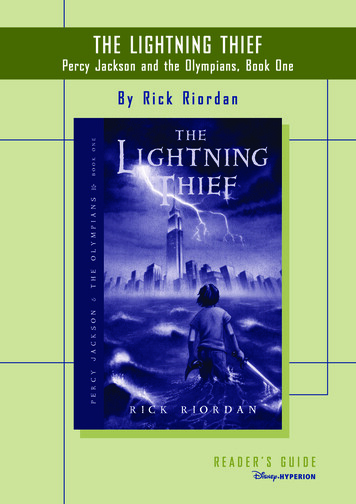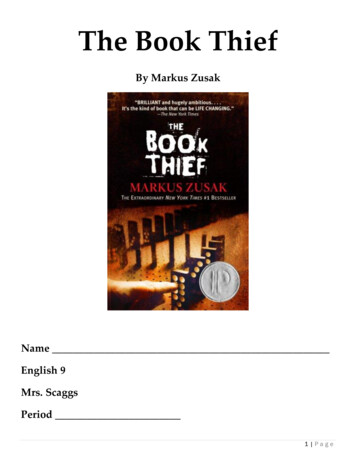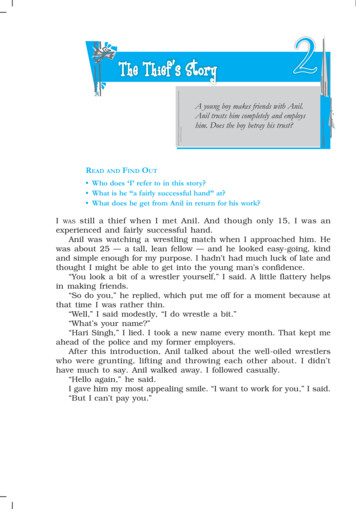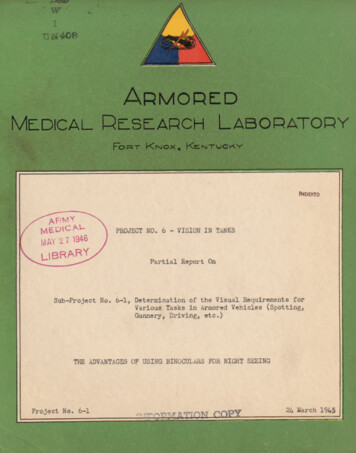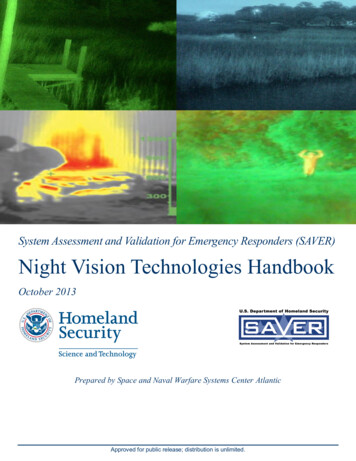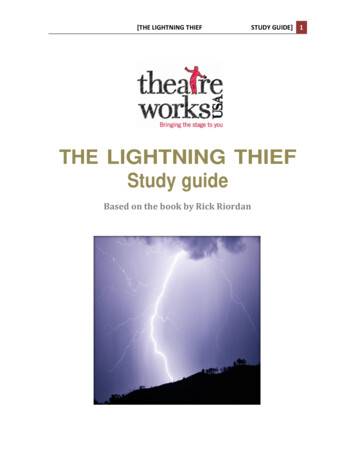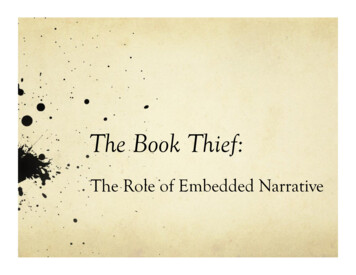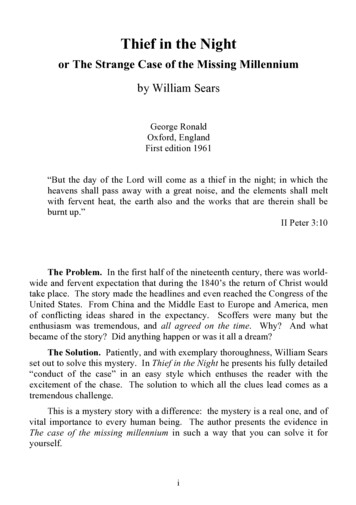
Transcription
Thief in the Nightor The Strange Case of the Missing Millenniumby William SearsGeorge RonaldOxford, EnglandFirst edition 1961“But the day of the Lord will come as a thief in the night; in which theheavens shall pass away with a great noise, and the elements shall meltwith fervent heat, the earth also and the works that are therein shall beburnt up.”II Peter 3:10The Problem. In the first half of the nineteenth century, there was worldwide and fervent expectation that during the 1840’s the return of Christ wouldtake place. The story made the headlines and even reached the Congress of theUnited States. From China and the Middle East to Europe and America, menof conflicting ideas shared in the expectancy. Scoffers were many but theenthusiasm was tremendous, and all agreed on the time. Why? And whatbecame of the story? Did anything happen or was it all a dream?The Solution. Patiently, and with exemplary thoroughness, William Searsset out to solve this mystery. In Thief in the Night he presents his fully detailed“conduct of the case” in an easy style which enthuses the reader with theexcitement of the chase. The solution to which all the clues lead comes as atremendous challenge.This is a mystery story with a difference: the mystery is a real one, and ofvital importance to every human being. The author presents the evidence inThe case of the missing millennium in such a way that you can solve it foryourself.i
ContentsPart One—The Unsolved Problem1. Once to Every Man and Nation . 1–52. The Strange Case of the Missing Millennium . 5–83. The First Promise . 8–114. The Second Promise . 11–165. The Third Promise . 16–216. Other Promises . 21–257. And Others Still . 25–298. Lift Up Your Heads . 29–319. The Mystery of the White Stone . 31–3510. The Rich Who are Poor . 3511. The Light that Blinds . 3812. For None Can Read . 4313. A Mysterious Springtime . 4714. The Living and the Dead . 5215. The Mouthpiece of God. 5816. One Shepherd but Many Folds . 6217. The Unmistakable Signs . 6618. Lightning from the East . 7219. The Vision of the Last Days . 7420. The Avalanche . 79Part Two—The Solution1. The Mystery Begins to Unravel . 842. The Remarkable Parallel . 873. The Twin Fires of Heaven . 904. The Witnesses . 945. The Hidden is Revealed. 986. The Glory of God . 102Part Three—The Proof1. The King from the Sunrise . 1072. Ancient Land of Mystery. 1103. Begotten in Babylon . 1144. The Amazing Micah . 1175. The Eight Astonishing Steps . 1236. No Need of the Sun . 1277. The Families of the Earth Shall Be Blessed . 1328. The Lord of the New Era . 1379. The Door of Hope . 14410. Where the Poor are the Kings of Paradise . 152ii
11. The Blossoming Desert . 15912. Fire in the Sky! . 16513. He Shall Glorify Christ . 172Part Four—Signs in the Heavens1. The Signs in the Heavens . 1782. The Shaking Earth . 1813. The Blast of the Trumpet . 1834. When Stars Fell Like Snowflakes . 1865. The Face of Heaven . 1896. The Night Visitor . 194Part Five—The Final Evidence1. Beware of False Prophets . 2002. Enemy of the People . 2053. The Tree of Life. 2084. The First Fruit: Home and Family . 2105. The Second Fruit: Country . 2136. The Third Fruit: Religion . 2167. The Fourth Fruit: Individual Life . 2218. A Searching Eye . 2279. The Bird with Two Wings . 22910. The Real Treasury . 23111. No Man is a Stranger . 23312. Partners in Progress . 23513. The Beauty of the Rainbow . 23714. The Worlds Beyond . 24115. Food for the Soul . 245Part Six—The Challenge1. Except These Days be Shortened . 2512. Nuclear Giants and Ethical Midgets . 2563. The Chariots Shall Rage in the Streets . 2604. Terror in the Sky . 2655. The Hour Hath Come . 2716. The Day of the Lord . 2757. The Dawn of a New Day . 279REFERENCES . 284Index . 284-305iii
ForwardPassengers aboard Venus rocketArrive London airport tonightI admit that the headline intrigued me. Quickly I glanced at the frontpages of two other newspapers.Science proves soul immortalContinent of Atlantis rises insea off PortugalI looked across the television news desk at the editor.‘Anything else?’He pointed.Medical discovery ends all diseaseHitler found alive in ViennaI nodded. ‘It’s the end of the world, all right.’He handed me the magazine in which these headlines were printed.‘Take it along and read it.’I went back to my desk in the Sports Department, opened the magazineand began to study it carefully. It was a shot in the arm. Only this morning Ihad felt like a detective who was trying to solve a crime one hundred yearsafter the deed had been committed. Until this moment, the trail had been verycold. At least this article encouraged me to go on with my search. Apparently,thousands of people were still as keenly interested in solving the mystery as Iwas, even after more than a century.iv
I took a folder out of my filing cabinet and with a soft black pencil wroteon it: The strange case of the missing millennium.The magazine article consisted of sample headlines from newspapers allover the country. Editors had been asked to submit to the magazine someimaginary headlines, headlines which, the editor felt, would be capable ofarousing the greatest possible excitement.They had chosen some dandies:Scholars prove Shakespeare really MarloweNo more winter everHoly Grail found in WalesConan Doyle contacts earthSanta Claus no mythI chuckled. The morning that all these headlines were printed wouldcertainly be a day to run for the hills.There was one particular effort that instantly gripped my attention.According to these hard-boiled newspapermen, this headline, if authentic,would be the most electrifying of all. This one, they said, would really rock theworld back on its heels. It consisted of only two words:Christ returnsI had been working on just such a news story for two years. I hadaccidentally come upon what I had considered to be an amusing and puzzlingmystery, and had already spent two years trying to solve it. It all beganharmlessly enough when someone handed me a book written by a namesake ofmine, Clara Endicott Sears. No relative. At least so they told me aroundSearsport and Vanceborro in Maine. If I had known what lay ahead, I mighthave burned the book right then and there.v
I was working a night-wire for the United Press at the time, so I had a fewhours in which to sit and think. In Clara’s book I found an entertaining andfascinating story about the people who had eagerly awaited the return of Christduring the nineteenth century.My big surprise came when I learned that magazines and newspapers inthat day had actually printed stories about this spectacular event. Some weretold in jest, some in ridicule and some with deadly seriousness. In the pressand on the streets, you could savour every emotion:Christ—coming or not?End of the world tomorrowJesus at the doorTerrifying comet alarms earthThe Advent: truth or hoax?Everyone enjoys a good suspense story, especially the kind of thrillimplied in the threatening words: ‘The end of the world!’ The prophets ofdoom had run the gamut, from the literalist who said, ‘The world will come toan end on Thursday, 23 November at seven p.m. beginning in the Ohio valleyand spreading north through Michigan’, to the earnest student of Scripture whowarned that ‘in the day the stars shall fall from heaven and the earth beremoved from her place.’There is no greater suspense story than this. It is filled with terror andmagic, and it had been told with fantastic fervour in the 1840s.Excited reports spread through the United States, Britain, Canada, Europe,Asia, even to Africa and Australia. People throughout those regions werestrongly warned to prepare for the sudden appearance of Christ, the results ofwhose ‘coming’vi
promised to be either delightful or disastrous, depending on the teller.The vast majority of people went on their way with tolerant, amusedsmiles. They pitied the victims of such fanaticism. Many, however, found it atime fraught with fear and panic. In pamphlets, on the platform, in the pulpits,and in the press, Bible scholars called upon a non-listening, uninterested worldto repent.‘Now is the hour!’ they threatened.Many believed them. Whole families sold their homes and possessions.Others cashed in their bank accounts and gave away their worldly goods to theunbelieving. Some prepared special ascension robes. Tradition states thatsome went up into the hills on a fatal, chosen day to await the descent of Christupon a cloud, only to be greeted by a downpour of rain.I examined actual legal records in which some of the zealous deeded theirproperty over to the coming Christ. An entire village was prepared for Hiscoming. It was called Heaven (Paradise), and was established as His Americanresidence.A passionate madness seized people in widely separated sections of theChristian world at that time. Why? Why did they all expect Christ? Why atthat particular time?It was a puzzling, first-class mystery story. It was as though a ‘millennial’virus had suddenly infected people in five continents. As I read about thecolourful, amusing, and sometimes shocking things that happened in thesewidely scattered parts of the world, I became curious, and that curiosity was thebeginning of this volume.I can’t honestly say whether it was in the Library, the Museum, or by theCave of Elijah on Mount Carmel that I suddenly found myself engrossed in afascinating full-timevii
study. The growth of interest had been gradual, but eventually I wasdetermined to find out whether the return of Christ was a myth, a mistake, orthe greatest unsolved mystery of our age.One day in the reference room of one of the endless libraries I hauntedduring this period, I experienced a sudden, unique thrill, the sort thearchaeologist must feel when his pick strikes a wall and he sees it crumblebefore his eyes, revealing an ancient, exciting new world, at the very momenthe was about to abandon his search.I discovered I was not on a wild-goose chase! Among those dusty libraryshelves I found a fellow-detective, and in his company the excitement of thechase began all over again. Professor E. G. Browne of Pembroke College,Cambridge, had broken the ground before me. He, too, apparently had beenfascinated by the same story and had already unravelled a part of it. He wrotelikening it to the story of Christ:‘I feel it my duty, as well as pleasure to bring the matter to the notice ofmy countrymen ’1Later I traced Browne’s searching steps in the Holy Land; I read the letterin his own handwriting in which he made plans to come to Israel to meet thisgreat Figure. He admitted that he would not rest until he had settled the matterin his own mind.2I found that a contemporary of Browne’s, the renowned Benjamin Jowettof Balliol College, Oxford, has echoed this feeling. He, too, had chanced uponthe story that now lay open before me. He wrote:“It is too great and too near for this generation to comprehend. The futurealone can reveal its import.”3Both Professors Browne and Benjamin Jowett associated their dis-123E. G. Browne, quoted preface to The Chosen Highway, Lady Blomfield, 1940, pp.v–vi.E. G. Browne, letter to Mírzá ‘Alí Áqá Shírází, from Cambridge University, 9April 1889.The Bahá’í World, Vol. XII, p. 625.viii
covery with the return of Christ. They both expressed keen interest in therelevance and import of the story. Now, after several years of careful researchand study, I, too, had arrived at this same conclusion. I decided to take up thestory where they had left it and to follow it to its end.The following chapters are the record of my seven years of search; theyoffer my solution to this intriguing century-old mystery. They suggest that ourmodern newspapermen are one hundred years too late in wishing that they wereable to print the dramatic headline:Christ returnsIn fact, our press has been scooped by over a century. You will find hereconsiderable evidence to show that when the newspapers and publications ofthe 1840s printed their stories headed, Return of Christ expected, they wereprinting not fancy, but fact, even though they were unaware of the nature of thestory at the time, and were totally unable to substantiate its truth in that hour.If what I have uncovered is the truth, then (according to the testimony ofthe hard-boiled newspaper editors of the West) it is the most shocking anddramatic story that anyone could possibly tell in print.But will anyone believe me?You are now starting where I started a few years ago on The strange caseof the missing millennium.William Sears.ix
Part I—The unsolved problem1. Once to every man and nationMy first step was to investigate that period in history between the years1830 and 1850. It was a time of strange and troublesome events. Men staredin wonder and uneasiness at the great halo that circled the sun. They looked upfearfully at the night sky where a giant comet with a fiery tale rushed throughthe darkness. Some said that the comet was racing toward mankind bringingthe ‘end of the world’.An interesting account of this period reads:“A converted Jew in Palestine, Joseph Wolff, predicted the Advent (ofChrist) for 1847. Harriet Livermore, an eloquent and arresting woman ofthe time, who figures in Whittier’s Snowbound, preached the SecondComing everywhere, including the House of Representatives atWashington, where crowds gathered to hear her. Lady Hester Stanhope, avaliant madwoman, niece of William Pitt, who turned her back on Londonand power and fashion, made her home in Lebanon among the Arabs andDruses, in order to be ready and near to the scene of the Advent. She kept,it was reported, two white Arab steeds in her stable, one for the Messiah,one for herself!”1Another writer stated:“There is a little mosque, we are told, in the Holy Land, where a priestpresides, keeping ready the shoes that the Messiah is to wear when hecomes to Jerusalem.”212The Story of Prophecy, Henry James Forman, 1936, pp. 310–311.Star of the West, XIV:10, p. 304.1
It was said of those days:“So real was the hope of the Advent, people were actually taking almostviolent measures for it. It was the nineteenth century, yet the shootingstars of the year 1833, and the perihelia, or halo-like rings, around the sunin 1843, were objects of the most awesome speculation and discussion.And the tail of the great comet of 1843 measured 108 million miles inlength. Whole families were engaged in making shrouds against thatfateful day.”1Some of the more zealous believers, it is said, donned their ‘ascensionrobes’ and prepared to await Christ’s descent upon the clouds of heaven.Their more sceptical, and practical, but equally uninformed neighbourspointed out that clouds did not descend, but were vapours that rose up from theearth.Other scholars quoted St. Augustine who had written an entire volumeproving that there could not be anyone living on the other side of the earthbecause it would then be impossible for such people to see Christ when Hecame down in the clouds on the day of His return.Mathematicians asked: “Which way is down?” Furthermore, they said,taking into consideration the curvature of the earth, there would have to bethousands and thousands of ‘solo’ flights to the earth by Christ before allhumanity would be able to see His descent. They poked fun at the literalists inmany other ways, saying that obviously this coming down on the clouds wassymbolical.Still others suggested that perhaps these clouds were not a chariot thatChrist rode from heaven, but a mist that arose from earth to obscure man’svision.However, in spite of scepticism and doubt, designers created special‘ascension robes’ in various styles for the great coming event, especially forthose who wished to be in fashion1The Story of Prophecy, Foreman, pp. 310–311.2
on that day. It is said that they were displayed in some of the shop windows inthe eastern parts of the United States. Although this matter of ascension robeshas been hotly denied in many quarters, I frequently encountered the story.The following letter, one among many, makes this point quite evident.The letter was written by Ida M. Wing to Clara Endicott Sears on 21 August1921. It reads:“I have heard my mother tell that when she was a girl she remembers thather mother made a white robe, put her house in order, put lamps in thewindows and sat up all night waiting for the end of the world to come.”1When the great comet of 1843 streaked across the heavens, people pointedat it with alarm, saying:“It is now the hour for Christ’s return!”In that same year, the poet James Russell Lowell wrote:“Once to every man and nation comes the moment to decide,Some great cause, God’s new Messiah ”2The great poet Lamartine, in a flood of praise, asked of God: “Is this notthe time for you to reveal yourself?”On 24 May 1844, in Washington D.C., Mr Samuel F. B. Morse, theinventor of the telegraph, stepped to the keyboard of his new instrument. Hewas about to send the first official telegram in history flashing along the wiresfrom Washington to Baltimore. The press had heralded this day as a modernmiracle. By this invention, it was said, the world would be united physically inthe twinkling of an eye. These lightning-like impulses leaping along the wireswould shrink the size of the planet, they said.In fact, when Congress appropriated 40,000 for Morse to continue hiswork, he was told that now he could send his “lightnings” to the world. Thushis invention was associated12Days of Delusion, Clara E. Sears, 1924, pp. 259–260.The Present Crisis, James Russell Lowell.3
with the words in the Book of Job, although at the time it was said partly in jest.Students of Scripture asked: “Is this not still another proof that 1844 isindeed the hour for the appearance of Christ? Is it not written in the Book ofJob that only God can send ‘lightnings that may go and say unto thee here weare!’1 Does it not mean that Christ is here? Does not this same Job promise”:“For I know that my redeemer liveth, and that he shall stand at the latterday upon the earth.”2Samuel Morse put his hand to the keyboard of the telegraph and tappedout that first formal message. The words were taken from the Book ofNumbers:“What hath God wrought!”3I was curious about that message of Morse in 1844. What had Godwrought in that day, if anything besides the telegraph? Was there a hiddenstory? Was it possible to find it? At least this was a beginning.About this time, I came upon the account of a lecture given by the Britishscientist, Sir Lawrence Bragg, in Carnegie Hall, New York. Sir Lawrencedrew a graph of the scientific achievements of man until the period around1844. He showed that man’s advancement up until that time had been veryslow, so slow, indeed, that the line of the graph up to 1844 was almosthorizontal.Subsequently, however, and immediately, the line of the graph wentalmost directly upwards, and has continued to climb ever since.This did interest me. Why? What had caused this new spirit of energyand creation in the world following the year 1844? Why had it begun in thatparticular period?123Job 38:35.Job 19:25.Numbers 23:23.4
Had some historical event taken place in 1844 that could account for thisnew upsurge of knowledge and invention? Was there some happening that thehistorians had overlooked, or neglected? Did it have anything to do with thecoming of the Messiah, the generally talked about return of Christ in that veryyear?These were questions to which I now eagerly wanted the answer. Thecase of the missing millennium was at last becoming interesting. I decided tomake a thorough check on the exact year of Morse’s 1844 message.2. The strange case of the missing millenniumI soon discovered that the year 1844 figured more prominently in thecalculations of millennial Bible scholars than any other year. Many of thesestudents of Scripture, working independently of each other in separatecontinents, arrived at almost the identically same time for the return of Christ.It was the period 1843–5.Wolff in Asia, Edward Irving in England, Mason in Scotland, Davis inSouth Carolina, William Miller in Pennsylvania, Leonard H. Kelber inGermany, and many others in various parts of the world believed that this wasindeed the ‘time of the end’.1These Bible scholars did not all agree on the exact date, nor did they allexplain the prophecies in a like manner. However, it was said of them:“ In America, Europe, and Asia the clear message of the ending of theprophetic time in 1844 was proclaimed with power by many voices.”2Andrew Jackson Davis delivered 157 lectures in New York in 1845.Edgar Allen Poe attended regularly, and heard12The Bahá’í World, Vol. V, p. 604.Our Day in the Light of Prophecy, W. A. Spicer, 1925, p. 241.5
Davis foretell the time when travel advertisements would read, ‘Through toCalifornia in four days!’ Davis also foretold the future speed of air travel. Herepeatedly lauded the wonder of the new age that was coming, calling it amaterial heaven that was a preparation for the spiritual kingdom. He said, “Aglorious period is before mankind. Fall in love with the new dispensation.”1William Miller began lecturing in 1831 concerning the return of Christ.He declared that he couldn’t help himself, that a voice kept urging him on,saying, ‘Go tell the world.’ In 1832, he wrote: “The evidence flows fromevery quarter Behold the Saviour comes!”2Forman, in his Story of Prophecy says, “The causes for religious stirringswere at that period in the air and umbiquitous”.3 He points out that Emersonattended a convention on Universal Reform and himself commented on thewide variety of those present, from madmen to philosophers. In Emerson’sown words, they were “madmen, madwomen, men with beards, Dunkers,Uggletonians, Come-Outers, Groaners, Agrarians, Seventh-Day Baptists,Quakers, Abolitionists, Calvinists, Unitarians and Philosophers.”4No wonder Clara Endicott Sears subtitled her book, A Strange Bit ofHistory.Just as 1844 approached, a clergyman of the Church of England, MourantBrock, made the following statement:“It is not merely in Great Britain that the expectation of the near return ofthe Redeemer is entertained, and the voice of warning raised, but also inAmerica, India, and on the continent of Europe. In America about threehundred ministers of the Word are thus preaching this gospel of thekingdom; whilst in this country, about seven hundred of the Church ofEngland are raising the same cry.”5I realized that with over a thousand clergymen in two12345The Pentralia, Andrew Jackson Davis, Boston, 1846.The Story of Prophecy, Foreman, pp. 309–310.The Story of Prophecy, Foreman, p. 310.New York Tribune, 20 November 1878.New York Tribune, 20 November 1878.6
countries alone preaching the return of Christ at that period, The case of themissing millennium became a story well worth investigating further.W. A. Spicer, in Our Day in the Light of Prophecy, wrote:“Here and there students of the Word saw that the 2300 year period ofDaniel 8:14, as explained in the ninth chapter, would end soon andlooked to the year 1844 as the time when the judgement would come.”Speaking of this unique convergence of prophecies upon the year 1844,Spicer wrote:“Witnesses were raised up in Europe, in Holland, Germany, Russia, andthe Scandinavian countries. Joseph Wolff, the missionary to the Levant,preached in Greece, Palestine, Turkey, Afghanistan, and other regions, thecoming of the judgement hour.”The millennial zeal reached its climax in the year 1844. I wanted to knowexactly why. What had led all these people to the same year?I found the answer. This date in history had been chosen primarilybecause of three specific promises made by Christ Himself to His disciples. Hegave three promises, saying that when these three things came to pass, He(Christ) would return to earth. The promises are as follows:1.2.3.His Gospel would be preached everywhere on earth.The ‘times of the Gentiles’ would be fulfilled, and the Jews wouldreturn to Israel (Palestine).All mankind would see the ‘abomination of desolation’ foretold byDaniel the Prophet.My next step, therefore, was to take up these three promises in order, andto follow this clue to its conclusion.7
My plan was simple. I would (1) find each promise made by Christ in theScriptures, (2) decide exactly what Christ had promised to His disciples, (3)determine if these three prophesies had actually been fulfilled, and (4) if theyhad been fulfilled, just when and how.I was no longer dealing with theory: I now had something specific toconsider.3. The first promiseThe first promise of Christ was easy to find. He made it to His disciples indirect reply to their questions. They asked Him:“Tell us, when shall these things be? And what shall be the sign of thycoming, and of the end of the world?”1This verse is found in the twenty–fourth chapter of Matthew. Christ thengave His disciples in the following words:“But he that shall endure until the end, the same shall be saved. And thisgospel
set out to solve this mystery. In Thief in the Night he presents his fully detailed “conduct of the case” in an easy style which enthuses the reader with the excitement of the chase. The solution to which all the clues lead comes as a tremendous challenge. This is a mystery s


